 |
Consequences of Vatican II
St. Peter and the Vatican Exhibit:
Marvelous Continuity and Shocking Change
Marian T. Horvat, Ph.D.
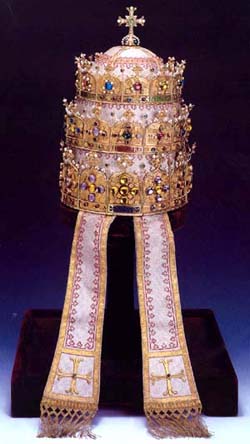 |
Papal tiara of Pope Pius IX
The tiara symbolized the Pope’s power as described in the formula used for its imposition: Patrem Principum et Regum, Rectorem orbis, in terra Vicarium Salvatoris Nostri Iesu Christi (Father of Princes and Kings, Ruler of the World, Vicar on Earth of Our Savior Jesus Christ).
|
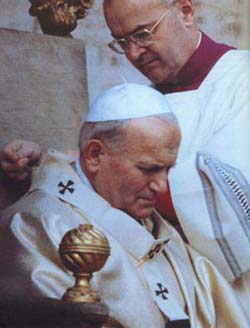 |
The Pallium of John Paul II
Doing away with both the traditional triple crown and the ceremony of coronation, John Paul II chose to be invested only with the pallium, above. |
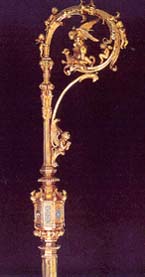  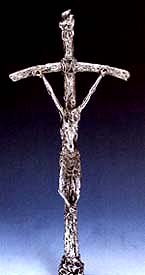 |
Crosier of Pope Leo XIII & Staff of Paul VI
The crosier, left, symbolizes a Bishop’s juridical and doctrinal power. The bottom of the staff is pointed because the shepherd of souls “has to prod the lazy and defend the weak,” as well as “gather in the strays,” according to the Bishop’s ceremonial.
It was replaced by Paul VI with the staff, right, which was adopted by John Paul II. |
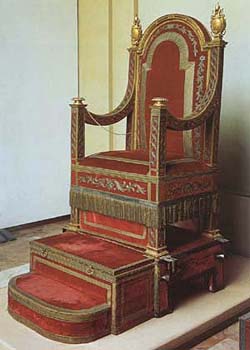 |
Sedia gestatoria of Pius VII
This rich red velvet throne carried the Pope for solemnities and public functions. The throne was borne on the shoulders of 12 sediari, chair-carriers.
Use of the chair was abolished in September 1978 during the brief pontificate of John Paul I. |
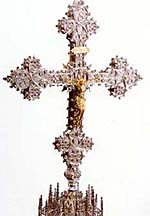 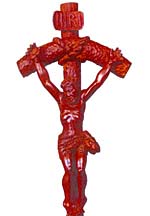 |
Processional Crosses, past and present
The silver gilt and enamel cross, left, was carried by the Pope in the procession opening Vatican I.
The ebony processional Cross with a muscular Christ and savage features, right, was used by John Paul II at a Mass on his trip to Africa.
|
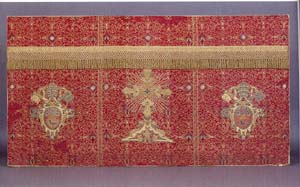 |
Antependium of Pope Innocent X
This antependium, or altar frontal, is a framed decorative hanging in silk and gold thread. Altar frontals were often made of marble, wood or metal and were a regular part of the church altars until the “reforms” of Vatican II did away with them. |
With so many startling innovations that have come from the Vatican and those who occupy the throne of St. Peter since Vatican Council II, here is a good surprise: The exhibition St. Peter and the Vatican: The Legacy of the Popes. The exhibit, which drew good crowds in Houston, Fort Lauderdale, and Cincinnati, closes on the West Coast in San Diego (May 15 to September 6, 2004) in the magnificent Balboa Park, an imposing Spanish Colonial architectural ensemble of buildings and monuments that hosts many museums.
The exhibit is billed as a “once in a lifetime opportunity” to view an extraordinary Vatican collection that chronicles the history of the See of Peter. The advertisement is not a hyperbole. One could travel to Rome and spend several weeks, and still not see all of the 353 objects of this extraordinary display drawn from Vatican sources and other collections. The promotional materials states that 70 percent of these historical objects, rare documents, altar items, and works of art have, in fact, never been on display for visitors to the Vatican. They are here, tastefully arranged and very accessible in 12 “interactive” galleries with six themes beginning with the Tomb of St. Peter and ending with the New Millennium.
Belying the myth of American disdain for pomp and circumstance, the exhibit has found an enthusiastic public here in the U.S. Given this fact, I thought it would be useful to spotlight some of the Vatican gold and grandeur. It is my opinion that in many Americans there is a deep-seated yearning for the grand and aristocratic institutions that certain propaganda pretends we disdain.
This enthusiasm for the marvelous was evident in a couple in formal dress in our group who were obviously too young to remember many of the elaborate and richly conceived liturgical vestments and charming papal regalia characteristic of pre-Vatican II customs. The two young persons were viewing everything with appreciation, even a spirit of veneration. Since the post-Conciliar Popes have relegated the tiara, gestatory throne, apostolic crosier, Fisherman’s ring, flabelli and other symbols of papal royalty to the museums, the couple might not even have been aware of their existence until they viewed such marvels in the exhibit.
Perhaps this was the first time they were seeing items familiar to Catholics before the Council, such as jeweled reliquaries, rich altar frontals, and ornate maniples, stoles, and chausibles. I wondered if they had any memory of the delicately worked chalice veils and burses that covered the gold and silver vessels and emphasized the sacred nature of the chalices that hold the Precious Body and Blood of Our Lord. What their generation knows are rude chalices and patens, handed out to lay ministers for distribution of Communion taken in the hand without ceremony.
Accustomed to the crude kindergarten banners and bare tables imposed after Vatican II, the young couple may not have been familiar with the splendid antependium, the rich piece that decorated the front of the altar. Or the cartalogia, the ornately framed altar Mass cards in Latin that insured against liturgical innovations so common in the vernacular Mass of our days.
These magnificent and lavish symbols of the past served a very important function: they emphasized the role of Pope as King and Vicar of Christ. They created an atmosphere of respect that helped the faithful to understand, in a concrete way, the dogmas of the Petrine Primacy and Papal Infallibility. The tone such symbols set firmly supported the Church as the One True Church of God, with a spiritual and temporal dominion on this earth. The artifacts developed and perfected through the centuries spoke these truths without words.
What have replaced these symbolic items? Today we have the proletariat pope-mobile and the strange processional staff adopted by Paul VI and John Paul II with its distorted Christ on a plain Cross, arms turning downward. One distinguishes John Paul II not by his solemn vestments but by his simple white cassock and beanie. These are the new symbols of the Papacy known throughout the world. The contrast between past and present could not be more vivid.
What is clear is that the tone changed after Vatican II. Suddenly we began to see Popes who tried to appear more as a representative of the people, rather than God. The image of the Pope began to lose its transcendent character, to lose its sacral and elevated note, to become more vulgar and mundane, “immanent” with the people.
What stands out, therefore, in St. Peter and the Vatican exhibit is both a continuity that is admirable and a change that is shocking. In this walking tour through papal history, one sees a constant growth of the Church, symbolized by an ever-increasing perfection of artifacts that symbolized her holiness and majesty, as well as her militancy and missionary character. The Papal History opens and unfolds like a grand crescendo.
Then a change. The crescendo comes to an abrupt halt. The glorious and majestic strains are cut short after the Second Vatican Council. The general lines of the symbols that characterize the Petrine ministry these last forty years are considerably different from, when not opposed to, those that constituted the uniform line of conduct of a long and illustrious chain of past Popes.
Before my visit to the St Peter and the Vatican exhibit, I asked a friend who had recently returned from viewing it in San Diego for her impression. Without hesitation she replied, “Oh, it was wonderful, all those marvelous things from the past. So beautiful and majestic. And then all those horrible modern things – it was so sad to see them right next to the others and taking their place.” A very appropriate summation not only of the exhibit, but also the present day situation of Holy Mother Church.
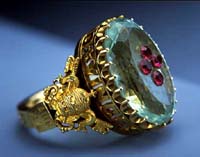
Ring of Pope Pius IX
Gold, aquamarine and red garnet |
|
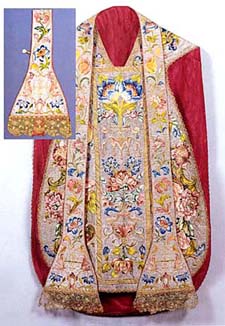
Maniple, Stole and Chausible of Pope Urban VIII
The silver leaf and gold trimmed ensemble represent the ornate pre-Vatican II vestments. After the Council, the chausible was changed, the stole simplified, and the maniple, at left, done away with.
|
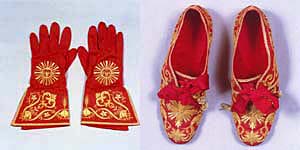
Papal Gauntlet and Slippers
Known as gauntlets, the ornamented gloves were worn during liturgical celebrations. The gloves and slippers varied in color according to the liturgical season. Paul VI was the last Pope to wear the gauntlets and slippers during liturgical ceremonies. |
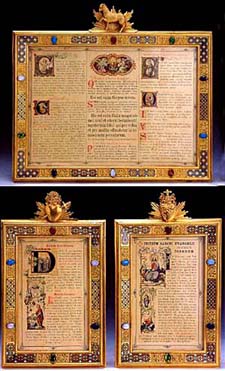 Altar Mass Cards Altar Mass Cards
The cartagloria, or altar Mass cards, were on every altar before Vatican Council II, which eliminated them. |
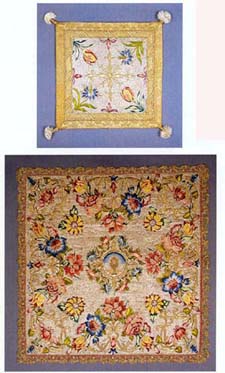 Chalice veil and burse of Pope Urban VIII Chalice veil and burse of Pope Urban VIII
Because of the sacred nature of the chalice, it was covered with a rich veil. Over the veil was placed the burse. In it was the corporal, a square of folded linen to catch any drop of the consecrated Bread and Wine. |
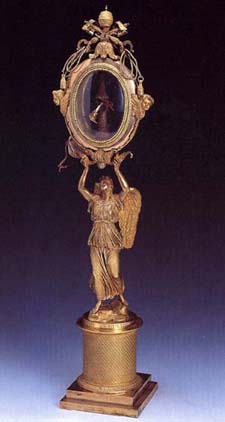
Reliquary of Pope St. Pius V
This gilded silver reliquary contains the
finger and ring of St. Pius V.
Before Vatican II, it was common for churches to
proudly display ornate reliquaries of the Saints
for the public to venerate. |
Sic transit gloria mundi (So passes worldly glory)
This brazier containing a piece of smoldering cloth was used in the papal coronation ceremony to remind the Pope to not be attached to his glory. The master of ceremonies would say,
“Sante Pater, sic transit gloria mundi,”
Today, the Sic transit ceremony and the coronation are gone.
|
|
Related Works of Interest
|
Art & Architecture | Hot Topics | Home | Books | CDs | Search | Contact Us | Donate

© 2002- Tradition in Action, Inc. All Rights Reserved
|
 |
|